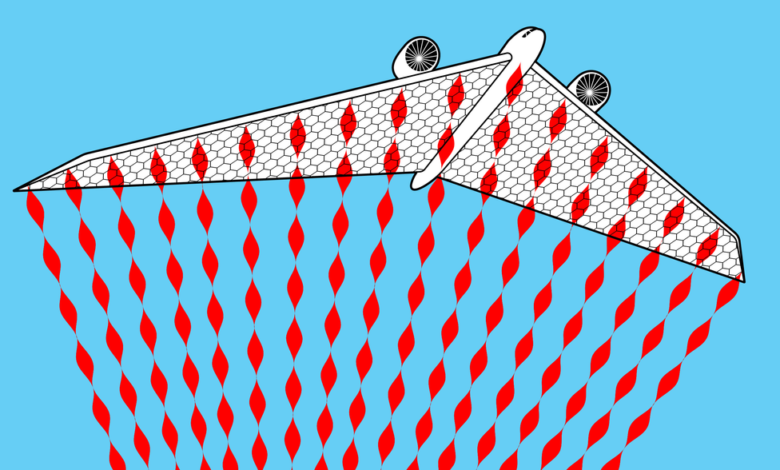Powering Planes With Microwaves Is Not the Craziest Idea

Imagine it’s 2050 and you’re on a cross-country flight on a new type of airliner, one with no fuel on board. The plane takes off, and you rise above the airport. Instead of climbing to cruising altitude, though, your plane levels out and the engines quiet to a low hum. Is this normal? No one seems to know. Anxious passengers crane their necks to get a better view out their windows. They’re all looking for one thing.
Then it appears: a massive antenna array on the horizon. It’s sending out a powerful beam of electromagnetic radiation pointed at the underside of the plane. After soaking in that energy, the engines power up, and the aircraft continues its climb. Over several minutes, the beam will deliver just enough energy to get you to the next ground antenna located another couple hundred kilometers ahead.
The person next to you audibly exhales. You sit back in your seat and wait for your drink. Old-school EV-range anxiety is nothing next to this.
Electromagnetic waves on the fly
Beamed power for aviation is, I admit, an outrageous notion. If physics doesn’t forbid it, federal regulators or nervous passengers probably will. But compared with other proposals for decarbonizing aviation, is it
that crazy?
Batteries, hydrogen, alternative carbon-based fuels—nothing developed so far can store energy as cheaply and densely as fossil fuels, or fully meet the needs of commercial air travel as we know it. So, what if we forgo storing all the energy on board and instead beam it from the ground? Let me sketch what it would take to make this idea fly.
Beamed Power for Aviation
Your browser does not support the video tag.
Fly by Microwave: Warm up to a new kind of air travel
For the wireless-power source, engineers would likely choose microwaves because this type of electromagnetic radiation can pass unruffled through clouds and because receivers on planes could absorb it completely, with nearly zero risk to passengers.
To power a moving aircraft, microwave radiation would need to be sent in a tight, steerable beam. This can be done using technology known as a phased array, which is commonly used to direct radar beams. With enough elements spread out sufficiently and all working together, phased arrays can also be configured to focus power on a point a certain distance away, such as the receiving antenna on a plane.
Phased arrays work on the principle of constructive and destructive interference. The radiation from the antenna elements will, of course, overlap. In some directions the radiated waves will interfere destructively and cancel out one another, and in other directions the waves will fall perfectly in phase, adding together constructively. Where the waves overlap constructively, energy radiates in that direction, creating a beam of power that can be steered electronically.
How far we can send energy in a tight beam with a phased array is governed by physics—specifically, by something called the diffraction limit. There’s a simple way to calculate the optimal case for beamed power: D1 D2 > λ R. In this mathematical inequality, D1 and D2 are the diameters of the sending and receiving antennas, λ is the wavelength of the radiation, and R is the distance between those antennas.
Now, let me offer some ballpark numbers to figure out how big the transmitting antenna (D1) must be. The size of the receiving antenna on the aircraft is probably the biggest limiting factor. A medium-size airliner has a wing and body area of about 1,000 square meters, which should provide for the equivalent of a receiving antenna that’s 30 meters wide (D2) built into the underside of the plane.
If physics doesn’t forbid it, federal regulators or nervous passengers probably will.
Next, let’s guess how far we would need to beam the energy. The line of sight to the horizon for someone in an airliner at cruising altitude is about 360 kilometers long, assuming the terrain below is level. But mountains would interfere, plus nobody wants range anxiety, so let’s place our ground antennas every 200 km along the flight path, each beaming energy half of that distance. That is, set R to 100 km.
Finally, assume the microwave wavelength (λ) is 5 centimeters. This provides a happy medium between a wavelength that’s too small to penetrate clouds and one that’s too large to gather back together on a receiving dish. Plugging these numbers into the equation above shows that in this scenario the diameter of the ground antennas (D1) would need to be at least about 170 meters. That’s gigantic, but perhaps not unreasonable. Imagine a series of three or four of these antennas, each the size of a football stadium, spread along the route, say, between LAX and SFO or between AMS and BER.
Power beaming in the real world
While what I’ve described is theoretically possible, in practice engineers have beamed only a fraction of the amount of power needed for an airliner, and they’ve done that only over much shorter distances.
NASA holds the record from an
experiment in 1975, when it beamed 30 kilowatts of power over 1.5 km with a dish the size of a house. To achieve this feat, the team used an analog device called a klystron. The geometry of a klystron causes electrons to oscillate in a way that amplifies microwaves of a particular frequency—kind of like how the geometry of a whistle causes air to oscillate and produce a particular pitch.
Klystrons and their cousins, cavity magnetrons (found in ordinary microwave ovens), are quite efficient because of their simplicity. But their properties depend on their precise geometry, so it’s challenging to coordinate many such devices to focus energy into a tight beam.
In more recent years, advances in semiconductor technology have allowed a single oscillator to drive a large number of solid-state amplifiers in near-perfect phase coordination. This has allowed microwaves to be focused much more tightly than was possible before, enabling more-precise energy transfer over longer distances.
In 2022, the Auckland-based startup Emrod showed just how promising this semiconductor-enabled approach could be. Inside a cavernous hangar in Germany owned by Airbus, the researchers beamed 550 watts across 36 meters and kept over 95 percent of the energy flowing in a tight beam—far better than could be achieved with analog systems. In 2021, the U.S. Naval Research Laboratory showed that these techniques could handle higher power levels when it
sent more than a kilowatt between two ground antennas over a kilometer apart. Other researchers have energized drones in the air, and a few groups even intend to use phased arrays to beam solar power from satellites to Earth.
A rectenna for the ages
So beaming energy to airliners might not be
entirely crazy. But please remain seated with your seat belts fastened; there’s some turbulence ahead for this idea. A Boeing 737 aircraft at takeoff requires about 30 megawatts—a thousand times as much power as any power-beaming experiment has demonstrated. Scaling up to this level while keeping our airplanes aerodynamic (and flyable) won’t be easy.
Consider the design of the antenna on the plane, which receives and converts the microwaves to an electric current to power the aircraft. This rectifying antenna, or rectenna, would need to be built onto the underside surfaces of the aircraft with aerodynamics in mind. Power transmission will be maximized when the plane is right above the ground station, but it would be far more limited the rest of the time, when ground stations are far ahead or behind the plane. At those angles, the beam would activate only either the front or rear surfaces of the aircraft, making it especially hard to receive enough power.
With 30 MW blasting onto that small of an area, power density will be an issue. If the aircraft is the size of Boeing 737, the rectenna would have to cram about 25 W into each square centimeter. Because the solid-state elements of the array would be spaced about a half-wavelength—or 2.5 cm—apart, this translates to about 150 W per element—perilously close to the maximum power density of
any solid-state power-conversion device. The top mark in the 2016 IEEE/Google Little Box Challenge was about 150 W per cubic inch (less than 10 W per cubic centimeter).
The rectenna will also have to weigh very little and minimize the disturbance to the airflow over the plane. Compromising the geometry of the rectenna for aerodynamic reasons might lower its efficiency. State-of-the art power-transfer efficiencies are only about 30 percent, so the rectenna can’t afford to compromise too much.
A Boeing 737 aircraft at takeoff requires about 30 megawatts—a thousand times as much power as any power-beaming experiment has demonstrated.
And all of this equipment will have to work in an electric field of about 7,000 volts per meter—the strength of the power beam. The electric field inside a microwave oven, which is only about a third as strong, can create a corona discharge, or electric arc, between the tines of a metal fork, so just imagine what might happen inside the electronics of the rectenna.
And speaking of microwave ovens, I should mention that, to keep passengers from cooking in their seats, the windows on any beamed-power airplane would surely need the same wire mesh that’s on the doors of microwave ovens—to keep those sizzling fields outside the plane. Birds, however, won’t have that protection.
Fowl flying through our power beam near the ground might encounter a heating of more than 1,000 watts per square meter—stronger than the sun on a hot day. Up higher, the beam will narrow to a focal point with much more heat. But because that focal point would be moving awfully fast and located higher than birds typically fly, any roasted ducks falling from the sky would be rare in both senses of the word. Ray Simpkin, chief science officer at Emrod, told me it’d take “more than 10 minutes to cook a bird” with Emrod’s relatively low-power system.
Legal challenges would surely come, though, and not just from the National Audubon Society. Thirty megawatts beamed through the air would be about 10 billion times as strong as typical signals at 5-cm wavelengths (a band currently reserved for amateur radio and satellite communications). Even if the transmitter could successfully put 99 percent of the waves into a tight beam, the 1 percent that’s leaked would still be a hundred million times as strong as approved transmissions today.
And remember that aviation regulators make us turn off our cellphones during takeoff to quiet radio noise, so imagine what they’ll say about subjecting an entire plane to electromagnetic radiation that’s substantially stronger than that of a microwave oven. All these problems are surmountable, perhaps, but only with some very good engineers (and lawyers).
Compared with the legal obstacles and the engineering hurdles we’d need to overcome in the air, the challenges of building transmitting arrays on the ground, huge as they would have to be, seem modest. The rub is the staggering number of them that would have to be built. Many flights occur over mountainous terrain, producing a line of sight to the horizon that is less than 100 km. So in real-world terrain we’d need more closely spaced transmitters. And for the one-third of airline miles that occur over oceans, we would presumably have to build floating arrays. Clearly, building out the infrastructure would be an undertaking on the scale of the Eisenhower-era U.S. interstate highway system.
Decarbonizing with the world’s largest microwave
People might be able to find workarounds for many of these issues. If the rectenna is too hard to engineer, for example, perhaps designers will find that they don’t have to turn the microwaves back into electricity—there are precedents for
using heat to propel airplanes. A sawtooth flight path—with the plane climbing up as it approaches each emitter station and gliding down after it passes by—could help with the power-density and field-of-view issues, as could flying-wing designs, which have much more room for large rectennas. Perhaps using existing municipal airports or putting ground antennas near solar farms could reduce some of the infrastructure cost. And perhaps researchers will find shortcuts to radically streamline phased-array transmitters. Perhaps, perhaps.
To be sure, beamed power for aviation faces many challenges. But less-fanciful options for decarbonizing aviation have their own problems. Battery-powered planes don’t even come close to meeting the needs of commercial airlines. The best rechargeable batteries have about 5 percent of the effective energy density of jet fuel. At that figure, an all-electric airliner would have to fill its entire fuselage with batteries—no room for passengers, sorry—and it’d still barely make it a tenth as far as an ordinary jet. Given that the best batteries have improved by only threefold in the past three decades, it’s safe to say that
batteries won’t power commercial air travel as we know it anytime soon.
Any roasted ducks falling from the sky would be rare in both senses of the word.
Hydrogen isn’t much further along, despite early hydrogen-powered flights occurring nearly 40 years ago. And it’s potentially dangerous—enough that some designs for hydrogen planes have included
two separate fuselages: one for fuel and one for people to give them more time to get away if the stuff gets explode-y. The same factors that have kept hydrogen cars off the road will probably keep hydrogen planes out of the sky.
Synthetic and biobased jet fuels are probably the most reasonable proposal. They’ll give us aviation just as we know it today, just at a higher cost—perhaps 20 to 50 percent more expensive per ticket. But fuels produced from food crops can be
worse for the environment than the fossil fuels they replace, and fuels produced from CO2 and electricity are even less economical. Plus, all combustion fuels could still contribute to contrail formation, which makes up more than half of aviation’s climate impact.
The big problem with the “sane” approach for decarbonizing aviation is that it doesn’t present us with a vision of the future at all. At the very best, we’ll get a more expensive version of the same air travel experience the world has had since the 1970s.
True, beamed power is far less likely to work. But it’s good to examine crazy stuff like this from time to time. Airplanes themselves were a crazy idea when they were first proposed. If we want to clean up the environment and produce a future that actually looks like a future, we might have to take fliers on some unlikely sounding schemes.
IEEE Spectrum




